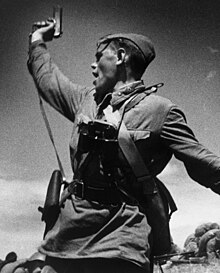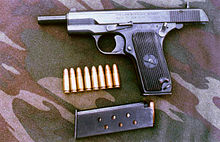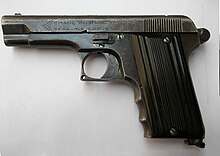TT pistol: Difference between revisions
Pakistan: Produced locally (Citation needed) |
No edit summary |
||
| Line 1: | Line 1: | ||
{{Infobox Weapon |
{{Infobox Weapon |
||
|name= TT |
|name= TT |
||
|image= [[File: |
|image= [[File:Tt tokarev 33.jpg|400px|thumb|center]] |
||
|caption= The improved TT-33 pistol. |
|caption= The improved TT-33 pistol. |
||
|origin= {{flag|Soviet Union}} |
|origin= {{flag|Soviet Union}} |
||
Revision as of 06:39, 1 March 2013
| TT | |
|---|---|
The improved TT-33 pistol. | |
| Type | Semi-automatic pistol |
| Place of origin | |
| Service history | |
| In service | 1930–present |
| Used by | See Users |
| Wars | World War II, Korean War, Chinese Civil War, Vietnam War, Laotian Civil War, Cambodian Civil War, Cambodian-Vietnamese War, Sino-Vietnamese War, Soviet war in Afghanistan, Cambodian–Thai border stand-off, and numerous others |
| Production history | |
| Designer | Fedor Tokarev |
| Designed | 1930 |
| Manufacturer | Tula Arsenal, Norinco, Femaru, Radom Arsenal, Cugir Arsenal, Zastava Arms |
| No. built | 1,700,000 |
| Variants | TT-30, TT-33, TTC, M48, M48 Tokagypt, M57, M70, M70, R-3, Type 51, Type 54, Type 68 |
| Specifications | |
| Mass | 854 g (30.1 oz) |
| Length | 194 mm (7.6 in) |
| Barrel length | 116 mm (4.6 in) |
| Height | 134 mm (5.3 in) |
| Cartridge | 7.62×25mm Tokarev |
| Action | Short recoil actuated, locked breech, single action |
| Muzzle velocity | 480 m/s (1,575 ft/s) |
| Effective firing range | 50 m |
| Feed system | 8-round detachable box magazine |
| Sights | Front blade, rear notch 156 mm (6.1 in) sight radius |
The TT-30 (Russian: 7,62-мм самозарядный пистолет Токарева образца 1930 года, 7,62 mm Samozaryadnyj Pistolet Tokareva obraztsa 1930 goda, "7.62 mm Tokarev self-loading pistol model 1930") is a Russian semi-automatic pistol. It was developed in the early 1930s by Fedor Tokarev as a service pistol for the Soviet military to replace the Nagant M1895 revolver that had been in use since Tsarist times, though it never fully replaced the M1895.
Development

In 1930, the Revolutionary Military Council approved a resolution to test new small arms to replace its aging Nagant M1895 revolvers.[1] During these tests, on January 7, 1931, the potential of a pistol designed by Fedor Tokarev was noted. A few weeks later, 1,000 TT-30s were ordered for troop trials, and the pistol was adopted for service in the Red Army.[2]
But even as the TT-30 was being put into production, design changes were made to simplify manufacturing. Minor changes to the barrel, disconnector,[3] trigger and frame were implemented, the most notable ones being the omission of the removable backstrap and changes to the full-circumference locking lugs. This redesigned pistol was the TT-33.[2] Most TT-33s were issued to officers. The TT-33 was widely used by Soviet troops during World War II, but did not completely replace the Nagant.
Design details
Externally, the TT-33 is very similar to John Browning's blowback operated FN Model 1903 automatic pistol, and internally it uses Browning's short recoil dropping-barrel system from the M1911. In other areas the TT-33 differs more from Browning's designs - It employs a much simpler hammer/sear assembly than the M1911, with an external hammer. This assembly is removable from the weapon as a modular unit and includes cartridge guides that provide reliable functioning. The Soviet engineers also added several other features such as locking lugs all around the barrel (not just on top), and made several alterations to make the mechanism easier to produce and maintain, notably a captive recoil spring secured to the guide rod which does not depend on the barrel bushing to hold it under tension. Production even machined the magazine feed lips into the receiver to prevent damage and misfeeds when a distorted magazine was loaded into the magazine well.[4]
The TT-33 is chambered for the 7.62x25mm Tokarev cartridge, which was itself based on the similar 7.63x25mm Mauser cartridge used in the Mauser C96 pistol. Able to withstand tremendous abuse, large numbers of the TT-33 were produced during World War II and well into the 1950s.
Variants


The Wehrmacht captured a fair number of TT-33s and issued them to units under the Pistole 615(r) designation. This was made possible by the fact that Russian 7.62 mm Model 1930 Type P cartridges were nearly identical to the German 7.63×25mm Mauser cartridge; therefore German ammunition could be used in captured Russian arms, and vice versa.[4]
Licensed production
Production of the TT-33 in Russia ended in 1954, but copies (licensed or otherwise) were also made by other countries.
The TT pistol copies made notably in China as the Type 51, Type 54,[5] M20, and TU-90
Poland produced their own copies as the PW wz.33, manufactured from 1947 to 1959 and Hungary rebarreled the pistol to fire 9×19mm Parabellum as the M48, as well as an export version for Egypt known as the Tokagypt 58 which was widely used by police forces there.[4]
Yugoslavia produced an improved version of the TT-33 as the M57, M65,[4] M70A and the 9×19mm M88. North Korea manufactured them as the Type 68[6] or M68.[4]
Romania also produced a TT-33 copy as the TTC, or Cugir Tokarov well into the 1950s. These have been made available for commercial sale in great numbers in recent years. However, to be importable into the United States, a trigger blocking safety was added.
Both legal and illegal TT pistols are still manufactured in various Pakistani Khyber Pass factories.
At one time or another most communist or Soviet bloc countries made a variation of the TT-33 pistol, until it was eventually replaced by the 8-round, 9×18mm Makarov PM pistol in 1952.
Production in China
The TT pistol was copied in China as the Type 51, Type 54,[5] M20, and TU-90.
Norinco, the People's Liberation Army's state weapons manufacturer in China, manufactured a commercial variant of the Tokarev pistol chambered in the more common 9×19mm Parabellum round, known as the Tokarev Model 213, as well as in the original 7.62×25mm caliber.
The 9mm model features a safety catch, which was absent on Russian-produced TT-33 handguns. Furthermore, the Model 213 features the thin slide grip grooves, as opposed to the original Russian wide-types. The 9mm model is featured with a magazine well block mounted in the rear of the magazine well to accept 9mm type magazines without frame modification.
The Norinco model in current production is not available for sale in the United States due to import prohibitions on Chinese firearms, although older handguns of the Model 213 type imported in the 1980s and 1990s are common.
7.62×25mm ammo is also rather inexpensive and locally produced or imported from China, also made by Norinco.
Usage


The TT-33 is still in service in the Chinese, Vietnamese and North Korean armed forces today while police in Pakistan still commonly use the TT pistol as a sidearm, though unofficially, as it is being replaced by modern 9 mm Beretta and SIG pistols.
The Tokarev is gaining in popularity with pistol collectors and shooters in the West because of its ruggedness, reliability and ready availability of cheap ammunition (in the US).
However, some complaints include poor-quality grips (which are often replaced by the wrap-around Tokagypt 58 grips) and a hand grip which extends at a vertical angle awkward for many Western shooters.
Another complaint is the poor placement of the post-production safeties installed to comply with US import regulations; many shooters disassemble the pistols, remove them and restore the Tokarevs to the original configuration.
Nonetheless, the Tokarev, as well as its variants in 9mm, is renowned for its simplicity, power and accuracy.[7]
Users
 Afghanistan[8]
Afghanistan[8] Albania:[8] Albanian police and RENEA.
Albania:[8] Albanian police and RENEA. Algeria[8]
Algeria[8] Angola[8]
Angola[8] Armenia[8]
Armenia[8] Azerbaijan[8]
Azerbaijan[8] Bangladesh: Uses Chinese Type 54 copy.[9]
Bangladesh: Uses Chinese Type 54 copy.[9] Belarus[8]
Belarus[8] Benin[8]
Benin[8] Bosnia-Herzegovina[8]
Bosnia-Herzegovina[8] Cambodia[8]
Cambodia[8] Chad[8]
Chad[8] People's Republic of China: Produced in large numbers as the Type 54.[10]
People's Republic of China: Produced in large numbers as the Type 54.[10] Congo-Brazzaville[8]
Congo-Brazzaville[8] Croatia[8]
Croatia[8] Egypt: Produced from the 1950s.[11]
Egypt: Produced from the 1950s.[11] Equatorial Guinea[8]
Equatorial Guinea[8] Georgia[8]
Georgia[8] Guinea[8]
Guinea[8] Guinea-Bissau[8]
Guinea-Bissau[8] Hungary: Produced locally.[12]
Hungary: Produced locally.[12] Iraq[8]
Iraq[8] Kyrgyzstan[8]
Kyrgyzstan[8] Laos[8]
Laos[8] Libya[8]
Libya[8] Lithuania: Lithuanian Armed Forces.[8][13]
Lithuania: Lithuanian Armed Forces.[8][13] Madagascar[8]
Madagascar[8] Malta[8]
Malta[8] Mauritania[8]
Mauritania[8] Moldova[8]
Moldova[8] Mongolia[8]
Mongolia[8] Montenegro[8]
Montenegro[8] Morocco[14]
Morocco[14] Mozambique[8]
Mozambique[8] North Korea: Produced locally as the Type 68.[12][15]
North Korea: Produced locally as the Type 68.[12][15] Pakistan: Used by Pakistan Army, [16] Security Guards and Police. It is being replaced by Modern 9 mm Beretta and SIG pistols.Produced locally. [citation needed]
Pakistan: Used by Pakistan Army, [16] Security Guards and Police. It is being replaced by Modern 9 mm Beretta and SIG pistols.Produced locally. [citation needed] Poland: Produced locally in the Radom arms factory.[12] Used by military and law enforcement groups; replaced by the P-64 pistol in the 1960s.
Poland: Produced locally in the Radom arms factory.[12] Used by military and law enforcement groups; replaced by the P-64 pistol in the 1960s. Romania: Produced locally.[8][12]
Romania: Produced locally.[8][12] Russian Federation[8]
Russian Federation[8] Serbia[8]
Serbia[8] Sierra Leone[8]
Sierra Leone[8] Somalia[8]
Somalia[8] Soviet Union[10]
Soviet Union[10] Syria[8]
Syria[8] Uganda[8]
Uganda[8] Vietnam[8]
Vietnam[8] Yugoslavia: Produced locally.[10][12]
Yugoslavia: Produced locally.[10][12] Zambia[8]
Zambia[8] Zimbabwe[8]
Zimbabwe[8]
See also
References
- ^ World.guns.ru. "Tokarev TT pistol (USSR/Russia)". Retrieved 2008-01-29.
- ^ a b Cruffler.com (2001). "Polish M48 (Tokarev TT-33) Pistols". Retrieved 2008-01-29.
{{cite web}}: Unknown parameter|month=ignored (help) - ^ Tokarev, Vladimir (2000). "Fedor V. Tokarev". Retrieved 2008-01-29.
- ^ a b c d e Bishop, Chris (2006). The Encyclopedia of Small Arms and Artillery. Grange Books. pp. 13–14. ISBN 978-1-84013-910-5.
- ^ a b Kokalis, Peter. Weapons Tests And Evaluations: The Best Of Soldier Of Fortune. Boulder, Colorado, USA: Paladin Press. p. 96. ISBN 978-1-58160-122-0.
- ^ Modern Firearms
- ^ AlphaRubicon.com, Information concerning the Norinco Type 213, its disassembly, and handling
- ^ a b c d e f g h i j k l m n o p q r s t u v w x y z aa ab ac ad ae af ag ah ai aj ak al am Jones, Richard D. Jane's Infantry Weapons 2009/2010. Jane's Information Group; 35 edition (January 27, 2009). ISBN 978-0-7106-2869-5.
- ^ http://www.bdmilitary.com/index.php?option=com_content&view=article&id=186&Itemid=95
- ^ a b c Marchington, James (2004). The Encyclopedia of Handheld Weapons. Lewis International, Inc. ISBN 1-930983-14-X.
- ^ Hogg, Ian (2002). Jane's Guns Recognition Guide. Jane's Information Group. ISBN 0-00-712760-X.
- ^ a b c d e http://world.guns.ru/handguns/hg/rus/tokarev-tt-e.html
- ^ http://kariuomene.kam.lt/lt/ginkluote_ir_karine_technika/pistoletai/pistoletas_tokarev_tt.html
- ^ [1]
- ^ http://www.fas.org/nuke/guide/dprk/nkor.pdf
- ^ "Pakistan Army".
